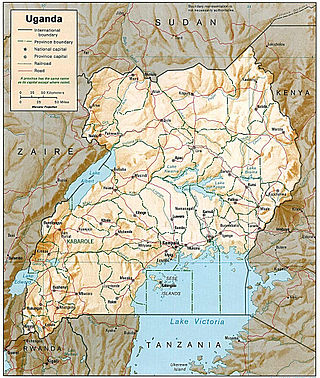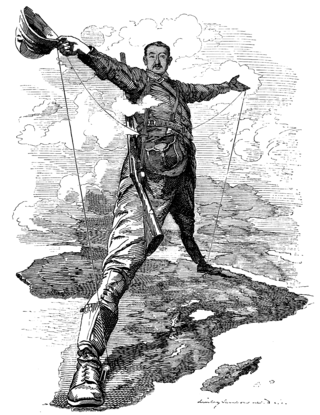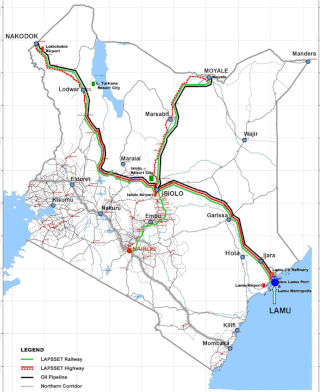There are a number of systems of transport in Burundi, including road and water-based infrastructure, the latter of which makes use of Lake Tanganyika. Furthermore, there are also some airports in Burundi.

Transport in Uganda refers to the transportation structure in Uganda. The country has an extensive network of paved and unpaved roads.

The Cape to Cairo Railway was an unfinished project to create a railway line crossing Africa from south to north. It would have been the largest and most important railway of that continent. It was planned as a link between Cape Town in South Africa and Port Said in Egypt.

Kenya Railways Corporation (KRC), also Kenya Railways (KR) is the national railway of Kenya. Established in 1977, KR is a state corporation.
Rail transport in Kenya consists of a metre-gauge network and a new standard-gauge railway (SGR). Both railways connect Kenya's main port city of Mombasa to the interior, running through the national capital of Nairobi. The metre-gauge network runs to the Ugandan border, and the Mombasa–Nairobi Standard Gauge Railway, financed by a Chinese loan, reaches Suswa.
Nimule is a city in the southern part of South Sudan in Magwi County, Eastern Equatoria. It lies approximately 197 kilometres (122 mi), by road, southeast of Juba, the capital of South Sudan and largest city in the country. The town also lies approximately 120 kilometres (75 mi), by road, north of Gulu, Uganda, the nearest large city.

Railway stations in Sudan include:
Railway stations in Kenya include:
Railway stations in Uganda include:
There are several planned railway lines in Rwanda, including a line to Tanzania. Historical railways are limited to three industrial railways.
Railway stations in Djibouti are served by standard gauge railways of the Djiboutian Railway Company.

The East African Railway Master Plan is a proposal for rejuvenating the railways serving Tanzania, Kenya, and Uganda and adding railways to serve Rwanda and Burundi. The objective is to further the economic development of eastern Africa by increasing the efficiency and speed, and lowering the cost, of transporting cargo between major ports on the Indian Ocean coast and the interior.

South Sudan does not have an extensive rail system. Current rail infrastructure, which was constructed between 1959–1962, and was left over from the previous Sudan government is in a serious state of disrepair. It consists of a 248 kilometers (154 mi) narrow-gauge, single-track line that connects Babonosa (Sudan) with the city of Wau in South Sudan. The line was left in poor condition after the Second Sudanese Civil War after several parts of it were mined; the line was fully rehabilitated with United Nations funds.

Lamu Port-South Sudan-Ethiopia-Transport (LAPSSET) Corridor project, also known as Lamu corridor is a transport and infrastructure project in Kenya that, when complete, will be the country's second transport corridor. Kenya's other transport corridor is the Mombasa - Uganda transport corridor that passes through Nairobi and much of the Northern Rift. Some basic LAPSSET infrastructure has been built. The construction of LAPSSET's main components is currently ongoing with construction of the first berth at Lamu Port completed in October, 2019 (situation as per October 2019).. Although the project is not formally stalled, its short to medium term success looks increasingly unlikely. Insecurity and political instability in Kenya are mostly to blame for this, as are more commercially viable alternative pipeline options through Tanzania or Ethiopia. The low oil prices since 2015 also affect LAPSSET's commercial prospects.
The Mombasa–Nairobi Standard Gauge Railway is a standard-gauge railway (SGR) in Kenya that connects the large Indian Ocean city of Mombasa with Nairobi, the country's capital and largest city. This SGR runs parallel to the narrow-gauge Uganda Railway that was completed in 1901 under British colonial rule. The East African Railway Master Plan provides for the Mombasa–Nairobi SGR to link with other SGRs being built in the East African Community.
Babanusa-Wau Railway is an international railway line from the town of Babanusa in Sudan to South Sudan's second largest city Wau. It terminates at Wau Railway Station. The 1,067 mm gauge railway line is 445.5 km long. 195.5 km are running on Sudanese territory, 250 km on South Sudanese territory. The South Sudanese section of the railway line is currently the only railway in South Sudan.
The Uganda Standard Gauge Railway is a planned railway system linking the country to the neighboring countries of Kenya, Rwanda, Democratic Republic of the Congo and South Sudan, as part of East African Railway Master Plan. The new Standard Gauge Railway (SGR), is intended to replace the old, inefficient metre-gauge railway system.
The Nairobi–Malaba Standard Gauge Railway (SGR) is the project of standard-gauge railway that should connect Kenya's capital city of Nairobi to Malaba, at the international border with Uganda. The Nairobi–Malaba SGR was to connect other standard gauge railways in Uganda, Rwanda, Burundi, South Sudan and eastern Democratic Republic of the Congo, under the East African Railway Master Plan.
The Kenya Standard Gauge Railway is a railway system that will connect Kenyan cities, and link the country to the neighboring country of Uganda, and through Uganda, to South Sudan, the Democratic Republic of the Congo, Rwanda, and Burundi. There are also plans to link to Addis Ababa, in neighboring Ethiopia to the north. The first segment, between Mombasa and Nairobi, opened passenger rail service in June 2017, and freight rail service in January 2018. Other segments are under construction or planned. The new Standard Gauge Railway (SGR), is intended to replace the old, inefficient metre-gauge railway system.








